
9 minute read
Port Otago – a rich history of primary exports
by CILTNZ
Reported to Lynne Richardson All photos courtesy of Port Otago
NEW ZEALAND’S PORTS
Port Otago – a rich history of primary exports
A ship leaving the Otago Harbour – Port Otago is the South Island’s principal primary export port
PORT OTAGO is located on the Otago Harbour of the South Island of New Zealand. It is the South Island’s primary export port and operates two wharf systems – Port Chalmers and Dunedin – within Otago Harbour. Port Otago benefits from a deep natural harbour, its strategic location for vessel rotation to and from deep-sea destinations, and a large primary export cargo region.
Owned by the Otago Regional Council, Port Otago has a rich and diverse history. The very first shipment of frozen meat from New Zealand left Port Chalmers, bound for London, in 1882. Some 90 years later, in 1970 the Port Chalmers container terminal was established, and the first container ship left Port Chalmers the following year.
The port company’s principal role is to facilitate trade for the region’s exporters and importers, and it has a significant impact on the economic, social and environmental wellbeing of Otago and Southland. The region has the infrastructure required for a successful port, including a fit-for-purpose road and rail network and a well-developed warehouse and cool storage sector.
Port Chalmers is located in the lower harbour. With a channel depth of 13.5m, it can accommodate vessels up to 360 m long and has three berths, suitable for handling containerised, multipurpose, log carriers and cruise ships. Berthing flexibility is guaranteed by a swinging basin dredged to 13.5 m, with a turning diameter of 487 m.
The Dunedin Bulk Port is situated in the upper harbour, with a channel depth of 8.5 m. Tankers, fishing vessels, bulk carriers and smaller vessels are the principal users, with a maximum vessel length of 180 m. Six berths are available, with the main products being fertiliser, fish, logs, oil and LPG. The wharves are adjacent to cold storage facilities (which service the meat, dairy, fishing and horticultural exports of the region).
Container trade
Port Chalmers is one of New Zealand’s two deepest container ports and services some of the largest container ships in the country’s trade. It can store more than 7000 containers and has the highest number of reefer (refrigerated container) points of any New Zealand port, with 1850. Container throughput for the last season was 191,900 TEU (20 ft equivalent units).

Logs are a principal export commodity – there is approximately 7 ha of log storage area available between Port Chalmers and Dunedin Bulk Port
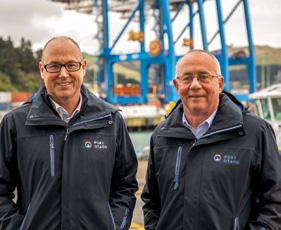
Kevin Winders, Port Otago chief executive (left) and Paul Rae, Port Otago chairman
Ships are serviced by two ZPMC cranes and a fleet of Kalmar straddles and side loaders. The principal exports are chilled and frozen meat, apples and fish, along with milk powder and MDF/timber, both of which are packed in Port Otago warehouses.
The company has more than 38,000 sq m of covered warehousing at Port Chalmers, built to the high standards required by the dairy industry. It also has two wharfside cold storage facilities in Dunedin, able to hold up to 10,500 tonnes of frozen product. This is used primarily to service fishing customers.
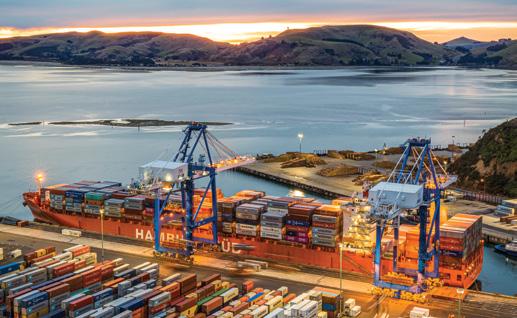
Port Chalmers is one of New Zealand’s two deepest container ports and services some of the largest container ships in the country’s trade
“We offer customers the option to book rail services from Southland and South Canterbury, which provides our customers and partners with cost-efficient options to transport their goods,” explains Craig Usher, Port Otago commercial manager. “We are a long way away from most markets and continuing to provide a high level of service and product offerings is key.”
Technological innovation
“One of the many safety initiatives we have implemented in recent years is our tip alert software that records and shares information on straddle carrier tip alerts,” says Mr Usher.
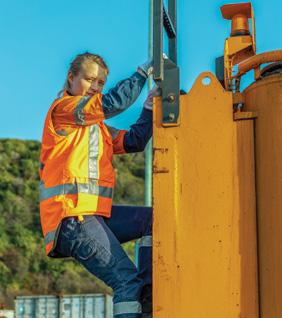
Keeping their team safe and ensuring they meet customers’ expectations around safety is essential at Port Otago.
“The potential for a 60 tonne straddle carrier to tip over and kill or seriously injure someone is a very real risk. Previously, manufacturer sensors alerted drivers if they breached a stability threshold, based on speed, turning radius and spreader height/ weight. However, the alert was only heard by drivers in the straddle cabs.”
The software installed in the company’s 15 straddle carriers in May 2018 automatically records and shares the tip alert data with shift supervisors. Red tip alerts – the most extreme alert level – dropped from 350 alerts per week to less than five per week in 2018/19. This low level of alerts has continued into 2020. “The impact of this safety measure is so dramatic that the default metric is now the more positive ‘average alert-free days per month’. Alertfree days did not exist two years ago. Now, the average number per month is 17,” Mr Usher says.
In 2020, Port Otago developed a vehicle booking system (VBS). Previously, trucks would arrive at any time to drop off or pick up cargo, but the new VBS allows Port Otago to smooth out truck arrivals. With about 1000 containers passing through Port Otago facilities each week, the upsides for the company are more efficient use of machinery, better coordination of container movements, and managing truck queues on public roads.
For trucking companies, the system minimises time spent queuing to access a port site. The new booking system also improves community safety, by avoiding queues of trucks forming. In the past, these queues have, at times, congested Port Chalmers’ George Street and main intersection. There are three VBS kiosks at Port Chalmers and one at Dunedin Depot. The Dunedin Depot kiosk was the first to be installed and the peak truck turnaround time has dropped from 30 minutes to less than 10 minutes.
Cruise ships
Port Chalmers is the primary South Island port for cruise ships and generally the port of call for ships immediately before or after visiting Fiordland. Prior to the Covid-19 pandemic, cruise ship numbers were increasing year-on-year. The 138 vessels booked for the 2020/21 season were expected to contribute more than $60 million to the local economy. This aspect of the business is currently on hold, with ships being temporarily banned from entering New Zealand waters as part of New Zealand’s response to the pandemic.
Bulk business
Port Otago is renowned for its bulk business, with principal commodities being logs, oil, fish, cement, LPG and fertiliser. The port company currently utilises storage and berths in both Port Chalmers and Dunedin Bulk Port. There is approximately 7 ha of log storage area available between both sites.
“The use of rail is often talked about. However, due to the close proximity of the two ports either side of us, our customers’ view is that once product is on a truck, then it is best to go direct to port,” notes Mr Usher.
In the financial year ending June 2020, 1.5 million tonnes of bulk cargo went through the port. This included 890,000 JAS of export logs (the Japanese Agricultural Standard cubic metre, or JAS, is a global industry standard measurement of log volume). Currently, the main fumigation chemicals are methol bromide for logs travelling on deck and phosphine for logs underdeck (a 10-day process). Export forestry products account for 94% of the methol bromide use in New Zealand. From 28 April 2021, recapture technologies or another approved product must be used. The Ministry for Primary Industries (MPI) has submitted research of ethanedinitrile (EDN) to key trading partners for assessment.
Property
Port Otago owns property in Dunedin, Hamilton and Auckland, and this is managed through a property-focused division. Its core activity is commercial property investment. The company manages its investment portfolio through activeacquisition, property development and, at times, divestment to produce a diversified portfolio by property type and location.
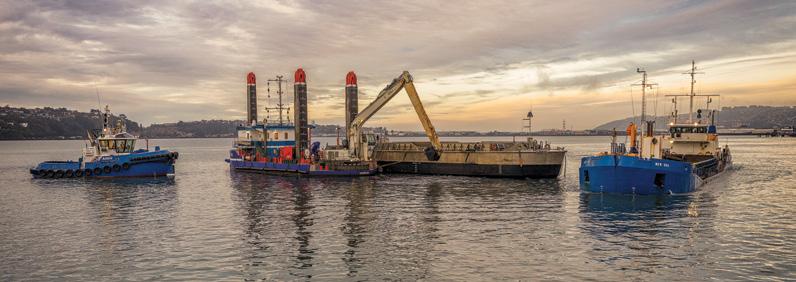
From Taiaroa Head to the container terminal at Port Chalmers, the harbour is dredged to accommodate vessels with a maximum draught of 13.5m
Port Otago’s property arm makes a significant contribution to its long-term financial sustainability and will remain an important part of the company’s balanced portfolio.
Embarking on a sustainability journey
Kevin Winders, Port Otago chief executive, says that as an organisation, Port Otago has been working towards a strategy for a better business. “In 2020, we embarked on ‘Integrated Thinking’, starting with a materiality process to understand what matters most to our stakeholders and the business.
Port Otago quick facts
• 319 employees as at 30 June 2020
• 476 container and bulk ships piloted through Otago Harbour in the last season
• 191,900 TEU container throughput in the last season
• 204,000 cruise passengers visited Dunedin during the 2019/2020 season
• 73,899 gross tonnage – the size of the largest container ship to visit Port Otago.
Value is measured in more than just dollars. Instead, we are now using internationally recognised ‘six capitals’ to communicate resources used and value created. We refer to these capitals within our organisation as: our team, our wider team, our harbour and beyond, our know-how and skills, our assets and our financial value,” he notes.
“This has been a pivotal year in the port’s sustainability journey. We completed our first materiality process and have developed our value chain thinking considerably. Now that we understand what is most important to our stakeholders and the port – alongside how we create and preserve value – we are working on our goals. These goals will make up our strategy for a better business, which we look forward to sharing with everyone.”
Port Otago team
Taking steps to reduce fatigue is a key focus for the port company for 2020/21. In the past year, significant initiatives were actioned: a new roster system was rolled out company-wide; a fatigue risk management system and working group were created; and a fatigue expert was appointed.
Dr Matthew Thomas is one of Australia’s leading experts in safety management in high-risk work environments. He has worked with other maritime and airline organisations, including Ports of Auckland, South Port, the Australian Maritime Safety Authority and several Australian ports. Dr Thomas has been appointed to review the port’s fatigue policy and rostering and training, in relation to the port’s fatigue risk profile for its operations.
With safety its primary benefit, TimeTarget software helps Port Otago’s workforce planners manage the risk of staff fatigue. Data is being analysed and rules around maximum working hours and minimum shift breaks applied. TimeTarget also improves transparency around shift work – a feature appreciated across the team. A fatigue working group was formed during the year, made up of representatives from the Maritime Union of New Zealand, the Rail and Maritime Transport Union, the port’s people and operations teams and Dr Thomas. This working group meets monthly and one of its critical tasks is designing a fatigue risk management system for Port Otago.
Port Otago leadership team
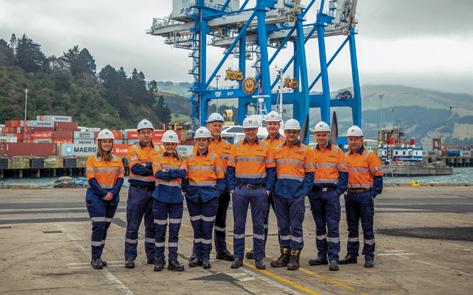
Port Otago leadership team (L–R): Kate Walton, Craig Usher, Jodi Taylor, Deanna Matsopoulos, Kevin Kearney, Kevin Winders, Gavin Schiller, Sean Bolt, Stephen Connolly, David Chafer
• Kevin Winders – chief executive
• Stephen Connolly – chief financial officer
• Sean Bolt – general manager, marine
• David Chafer – general manager, property
• Kevin Kearney – general manager, operations
• Deanna Matsopoulos – supply chain manager
• Gavin Schiller – head of safety
• Craig Usher – commercial manager
• Sandy Shea – general manager, information technology
• Kate Walton – people and capability manager
• Jodi Taylor – executive assistant.
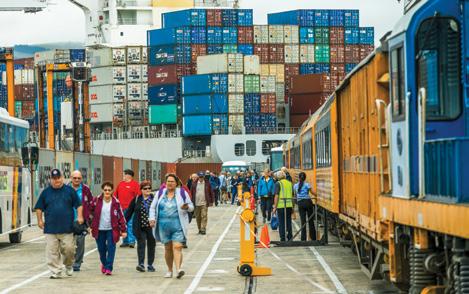
A busy day at the port, with a double cruise ship visit and the Taieri Gorge train alongside,picking up customers for a day excursion, while a container ship is worked inthe background
Lynne Richardson is the former editor of FTD and NZ Construction News magazines





